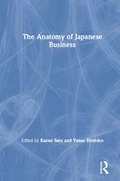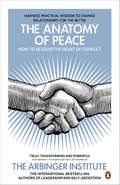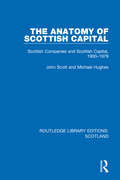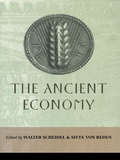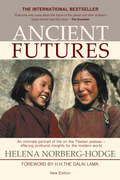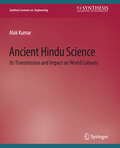- Table View
- List View
The Anatomy of Corporate Law: A Comparative and Functional Approach
by Reinier Kraakman John Armour Paul Davies Luca Enriques Henry Hansmann Gerard Hertig Klaus Hopt Hideki Kanda Mariana Pargendler Wolf-Georg Ringe Edward RockThis is the long-awaited third edition of this highly regarded comparative overview of corporate law. This edition has been comprehensively revised and updated to reflect the profound changes in corporate law and governance practices that have taken place since the previous edition. These include numerous regulatory changes following the financial crisis of 2007-09 and the changing landscape of governance, especially in the US, with the ever more central role of institutional investors as (active) owners of corporations. The geographic scope of the coverage has been broadened to include an important emerging economy, Brazil. In addition, the book now incorporates analysis of the burgeoning use of corporate law to protect the interests of "external constituencies" without any contractual relationship to a company, in an attempt to tackle broader social and economic problems. The authors start from the premise that corporations (or companies) in all jurisdictions share the same key legal attributes: legal personality, limited liability, delegated management, transferable shares, and investor ownership. Businesses using the corporate form give rise to three basic types of agency problems: those between managers and shareholders as a class; controlling shareholders and minority shareholders; and shareholders as a class and other corporate constituencies, such as corporate creditors and employees. After identifying the common set of legal strategies used to address these agency problems and discussing their interaction with enforcement institutions, The Anatomy of Corporate Law illustrates how a number of core jurisdictions around the world deploy such strategies. In so doing, the book highlights the many commonalities across jurisdictions and reflects on the reasons why they may differ on specific issues. The analysis covers the basic governance structure of the corporation, including the powers of the board of directors and the shareholder meeting, both when management and when a dominant shareholder is in control. It then analyses the role of corporate law in shaping labor relationships, protection of external stakeholders, relationships with creditors, related-party transactions, fundamental corporate actions such as mergers and charter amendments, takeovers, and the regulation of capital markets. The Anatomy of Corporate Law has established itself as the leading book in the field of comparative corporate law. Across the world, students and scholars at various stages in their careers, from undergraduate law students to well-established authorities in the field, routinely consult this book as a starting point for their inquiries.
The Anatomy of Entrepreneurial Decisions: Past, Present and Future Research Directions (Contributions to Management Science)
by Andrea Caputo Massimiliano M. PellegriniThe creation, success and long-term survival of enterprises are fundamentally linked to the effectiveness of decision-making processes and negotiation capabilities. This book provides an overview of research into how decisions permeate entrepreneurial ventures throughout their lifecycle. A multidisciplinary approach combining psychology, sociology and political science is used to investigate how entrepreneurs address and deal with decision-making. The respective contributions highlight the latest empirical, theoretical and meta-research, and bridge the gap between literature on entrepreneurship, entrepreneurial and innovative behaviours with that on decision-making and negotiation. This book is one of the first to combine these streams of research, thereby offering a new and insightful addition to the field of entrepreneurship.
The Anatomy of Fraud and Corruption: Organizational Causes and Remedies
by Tomas Brytting Richard Minogue Veronica MorinoThis ground-breaking book explores what happens when the fine line between competitive excellence and fraudulent and corrupt practice is crossed. Whilst most fraud literature focuses on the individual perpetrator, The Anatomy of Fraud and Corruption looks at how organizations as a whole and the people within it behave when fraud and corruption occur. By presenting a theoretical basis and a practical methodology for fraud risk awareness training, the book helps risk management professionals, and all those in critical corporate roles to redesign and train their organizations to strengthen their culture and become more resistant and resilient to the ever present threat of fraud and corruption. The Anatomy of Fraud and Corruption demonstrates that what we see as objective facts are not always what they seem. The qualified and uniquely experienced authors present a refreshing interpretation of Cressey's triangle of need, opportunity and rationalization. They employ a drama metaphor to reflect the interaction between fraudsters, victims and bystanders on the organizational stage. Corporate design, management and culture dictate what behaviour is normal or abnormal, whether it be manager and employee behaviour or their ability to become suspicious and question apparently improper actions. Using actual cases and investigations, the organizational conditions that give rise to fraud and corruption are explored. The authors then provide important insights as to how employees may be trained and motivated to reduce the likelihood and impact of fraudulent incidents. Whilst fundamentally a practical guide, this book is also essential reading for academics wanting to stay abreast of the latest developments in the study of ethics, organizational and work psychology and sociology, and criminology.
The Anatomy of Fraud and Corruption: Organizational Causes and Remedies
by Tomas Brytting Richard Minogue Veronica MorinoThis ground-breaking book explores what happens when the fine line between competitive excellence and fraudulent and corrupt practice is crossed. Whilst most fraud literature focuses on the individual perpetrator, The Anatomy of Fraud and Corruption looks at how organizations as a whole and the people within it behave when fraud and corruption occur. By presenting a theoretical basis and a practical methodology for fraud risk awareness training, the book helps risk management professionals, and all those in critical corporate roles to redesign and train their organizations to strengthen their culture and become more resistant and resilient to the ever present threat of fraud and corruption. The Anatomy of Fraud and Corruption demonstrates that what we see as objective facts are not always what they seem. The qualified and uniquely experienced authors present a refreshing interpretation of Cressey's triangle of need, opportunity and rationalization. They employ a drama metaphor to reflect the interaction between fraudsters, victims and bystanders on the organizational stage. Corporate design, management and culture dictate what behaviour is normal or abnormal, whether it be manager and employee behaviour or their ability to become suspicious and question apparently improper actions. Using actual cases and investigations, the organizational conditions that give rise to fraud and corruption are explored. The authors then provide important insights as to how employees may be trained and motivated to reduce the likelihood and impact of fraudulent incidents. Whilst fundamentally a practical guide, this book is also essential reading for academics wanting to stay abreast of the latest developments in the study of ethics, organizational and work psychology and sociology, and criminology.
Anatomy of Global Stock Market Crashes: An Empirical Analysis (SpringerBriefs in Economics)
by Gagari Chakrabarti Chitrakalpa SenThis work is an exploration of the global market dynamics, their intrinsic natures, common trends and dynamic interlinkages during the stock market crises over the last twelve years. The study isolates different phases of crisis and differentiates between any crisis that remains confined to the region and those that take up a global dimension. The latent structure of the global stock market, the inter-regional and intra-regional stock market dynamics around the crises are analyzed to get a complete picture of the structure of the global stock market. The study further probing into the inherent nature of the global stock market in generating crisis finds the global market to be chaotic thus making the system intrinsically unstable or at best to follow knife-edge stability. The findings have significant bearing at theoretical level and on policy decisions.
Anatomy of Government Deficiencies: Proceedings of a Conference held at Diessen, Germany July 22–25, 1980
by H. HanuschAnatomy of Japanese Business
by Kasuo SatoThis volume collects eleven essays written by Japanese experts on various aspects of Japanese business management and is a sequel to the volume Industry and Business in Japan. It examines the mechanisms for Japan 's phenomenal economic growth since the Second World War by analyzing Japanese management, business groups, production systems and business strategy.
Anatomy of Japanese Business
by Kasuo SatoThis volume collects eleven essays written by Japanese experts on various aspects of Japanese business management and is a sequel to the volume Industry and Business in Japan. It examines the mechanisms for Japan 's phenomenal economic growth since the Second World War by analyzing Japanese management, business groups, production systems and business strategy.
The Anatomy of Peace: How to Resolve the Heart of Conflict
by The Arbinger InstituteThe Anatomy of Peace will instil hope and inspire reconciliation. Through a series of moving stories about once-bitter enemies reunited, it shows us how we routinely misunderstand the causes of conflict - and perpetuate the very problems we're trying to solve. The Anatomy of Peace shows you how to:1. Focus on helping things go right, rather than 'fixing' things that go wrong2. Think about others as people with fears of their own, not obstacles in your way3. Stop worrying about how the world sees you4. Learn to move away from blame and bitternessWelcome to a world without conflict.
The Anatomy of Scottish Capital: Scottish Companies and Scottish Capital, 1900-1979 (Routledge Library Editions: Scotland #27)
by John Scott Michael HughesOriginally published in 1980, this book gives a concrete description of the development of Scottish companies and Scottish capital through the 20th Century, based on empirical study. The study begins with the major companies of 1904-5 and examines their history and subsequent development. The top companies in a number of periods are also examined and the study concludes with an investigation of the major companies of 1973-4 and their response to the (then) recent oil developments. The book uses both detailed company histories and broad historical interpretations as sources drawing the data together into chronologically ordered sections. Its focus is on the companies and people which make up the system of Scottish capital, seen as a relatively distinct system with its own characteristics and its own pattern of development within the British system.
The Anatomy of Scottish Capital: Scottish Companies and Scottish Capital, 1900-1979 (Routledge Library Editions: Scotland #27)
by John Scott Michael HughesOriginally published in 1980, this book gives a concrete description of the development of Scottish companies and Scottish capital through the 20th Century, based on empirical study. The study begins with the major companies of 1904-5 and examines their history and subsequent development. The top companies in a number of periods are also examined and the study concludes with an investigation of the major companies of 1973-4 and their response to the (then) recent oil developments. The book uses both detailed company histories and broad historical interpretations as sources drawing the data together into chronologically ordered sections. Its focus is on the companies and people which make up the system of Scottish capital, seen as a relatively distinct system with its own characteristics and its own pattern of development within the British system.
Anatomy of the Amazon Gold Rush (St Antony's Series)
by David ClearyIn 1979 this century's largest gold rush began in the Brazilian Amazon and has continued ever since. This book looks at the Amazon gold rush without sensationalizing it, at the politics and economics of gold in Brazil, and at the implications of the gold rush for Amazonia and its people.
Anbieter- und Vertragstypenwechsel: Eine nachfragerorientierte Analyse auf der Basis der Neuen Institutionenökonomik (neue betriebswirtschaftliche forschung (nbf) #319)
by Jost AdlerJost Adler entwickelt eine im Vergleich zu bisherigen institutionenökonomischen Ansätzen erweiterte Theoriebasis, die Transaction Choice Theory, und leitet zentrale Erklärungsgrößen des Anbieter- und Vertragstypenwechsels ab, die er in ein theoretisch konsistentes Modell integriert. Er unterzieht die dort analysierten Wirkungszusammenhänge einer empirischen Prüfung.
Anbieterseitige Kündigung von Kundenbeziehungen: Empirische Erkenntnisse und praktische Implikationen zum Kündigungsmanagement (Basler Schriften zum Marketing)
by Andreas LuccoAndreas Lucco entwickelt ein spezifisches Wirkungsmodell der wahrgenommenen Kündigungsqualität. Er identifiziert die kausalen Wirkungsbeziehungen zwischen der Kündigungsqualität, der daraus resultierenden Kundenemotion und der Einstellung gegenüber dem Unternehmen nach der Kündigung. In den praktischen Implikationen für ein kundenorientiertes Kündigungsmanagement zeigt der Autor idealtypische Segmente gekündigter Kunden und Ansatzpunkte für ein Qualitätsmanagement bei Kündigungen auf.
Anbieterzufriedenheit in industriellen Geschäftsbeziehungen: Das Beispiel Automobilindustrie (Business-to-Business-Marketing)
by Axel GawantkaAuf der Grundlage der Transaktionskostentheorie entwickelt Axel Gawantka ein Modell, das die Einflussfaktoren auf die Zufriedenheit von Anbietern in industriellen Geschäftsbeziehungen darstellt. Am Beispiel der Automobilindustrie zeigt er auf, welche Determinanten die Anbieterzufriedenheit besonders stark beeinflussen und welche Implikationen sich daraus für das Geschäftsbeziehungsmanagement ergeben.
Anchoring Innovation Districts: The Entrepreneurial University and Urban Change (Higher Education and the City)
by Costas SpirouAs universities transform cities with their innovation districts, what works in these new public-private partnerships?In recent years, the successful revitalization of urban areas has turned them into magnets for those looking for opportunities in a fast-paced and rapidly unfolding technology-based economy. After the economic crisis of 2008, many colleges and universities attempted to generate alternative sources of revenue and pursued aggressive economic development strategies. Some universities even began to actively invest resources in the rebirth (and rebranding) of urban cores, encouraging the development of entrepreneurial, technology-oriented innovation districts. In Anchoring Innovation Districts, Costas Spirou explains that these districts have emerged as geographic clusters of technology startups, business incubators, and accelerators. They aim to take advantage of intellectual capital, commercialize knowledge, and give their associated institutions a way to enter into the market. The outcome of robust private-public partnerships and complex real estate strategies, these initiatives also complement other urban revitalization efforts and reshape the socioeconomic makeup of city neighborhoods. Presenting readers with six case studies that explore the role of technological innovation, Spirou argues that higher education–anchored innovation districts can make significant contributions to economic expansion, job growth, and the institutions that guide their development. He also points out that these districts nonetheless raise questions about the impact of the Ivory Tower on the urban environment. Spirou focuses on Midtown Atlanta's Tech Square (Georgia Tech), Cambridge's Kendall Square (MIT), Philadelphia's University City (the University of Pennsylvania, Drexel University, and the University of the Sciences), the PHX Core (Arizona State University), and the role that the University of West Florida in Pensacola and the University of Tennessee at Chattanooga play in developing innovation ecosystems. Anchoring Innovation Districts provides unique insight into the transformative opportunities offered and the challenges faced by higher education in the built environment. University administrators, board members, policy makers, and scholars will find Spirou's analysis thought-provoking and helpful.
Anchoring Innovation Districts: The Entrepreneurial University and Urban Change (Higher Education and the City)
by Costas SpirouAs universities transform cities with their innovation districts, what works in these new public-private partnerships?In recent years, the successful revitalization of urban areas has turned them into magnets for those looking for opportunities in a fast-paced and rapidly unfolding technology-based economy. After the economic crisis of 2008, many colleges and universities attempted to generate alternative sources of revenue and pursued aggressive economic development strategies. Some universities even began to actively invest resources in the rebirth (and rebranding) of urban cores, encouraging the development of entrepreneurial, technology-oriented innovation districts. In Anchoring Innovation Districts, Costas Spirou explains that these districts have emerged as geographic clusters of technology startups, business incubators, and accelerators. They aim to take advantage of intellectual capital, commercialize knowledge, and give their associated institutions a way to enter into the market. The outcome of robust private-public partnerships and complex real estate strategies, these initiatives also complement other urban revitalization efforts and reshape the socioeconomic makeup of city neighborhoods. Presenting readers with six case studies that explore the role of technological innovation, Spirou argues that higher education–anchored innovation districts can make significant contributions to economic expansion, job growth, and the institutions that guide their development. He also points out that these districts nonetheless raise questions about the impact of the Ivory Tower on the urban environment. Spirou focuses on Midtown Atlanta's Tech Square (Georgia Tech), Cambridge's Kendall Square (MIT), Philadelphia's University City (the University of Pennsylvania, Drexel University, and the University of the Sciences), the PHX Core (Arizona State University), and the role that the University of West Florida in Pensacola and the University of Tennessee at Chattanooga play in developing innovation ecosystems. Anchoring Innovation Districts provides unique insight into the transformative opportunities offered and the challenges faced by higher education in the built environment. University administrators, board members, policy makers, and scholars will find Spirou's analysis thought-provoking and helpful.
Ancient Economies in Comparative Perspective: Material Life, Institutions and Economic Thought (Frontiers in Economic History)
by Marcella Frangipane Monika Poettinger Bertram SchefoldThis book investigates the economic organization of ancient societies from a comparative perspective. By pursuing an interdisciplinary approach, including contributions by archaeologists, historians of antiquity, economic historians as well as historians of economic thought, it studies various aspects of ancient economies, such as the material living conditions including production technologies, etc.; economic institutions such as markets and coinage; as well as the economic thinking of the time. In the process, it also explores the comparability of economic thought, economic institutions and economic systems in ancient history. Focusing on the Ancient Near East as well as the Mediterranean, including Greece and Rome, this comparative perspective makes it possible to identify historical permanencies, but also diverse forms of social and political organization and cultural systems. These institutions are then evaluated in terms of their capacity to solve economic problems, such as the efficient use of resources or political stability. The first part of the book introduces readers to the methodological context of the comparative approach, including an evaluation of the related historiographical tradition. Subsequent parts discuss a range of development models, elements of economic thinking in ancient societies, the role of trade and globalization, and the use of monetary and financial instruments, as well as political aspects.
The Ancient Economy (Edinburgh Readings On The Ancient World Ser.)
by Walter Scheidel Sitta von RedenThe Ancient Economy introduces readers to the nature of economic life in the ancient world, and provides a valuable guide to scholarly debates on the subject. The book describes and examines the economic processes and fluctuations of the ancient world, and shows how these relate to political and social change and conditions. Leading experts address the central issues, from agricultural production to the uses of money and the creation of markets. Taken as a whole the book exemplifies the range of interdisciplinary perspectives on the ancient economy, and illustrates the methodological approaches scholars have deployed to understand it. In doing so it draws on literary, ecological and archaeological evidence.
The Ancient Economy
by Walter Scheidel Sitta von RedenThe Ancient Economy introduces readers to the nature of economic life in the ancient world, and provides a valuable guide to scholarly debates on the subject. The book describes and examines the economic processes and fluctuations of the ancient world, and shows how these relate to political and social change and conditions. Leading experts address the central issues, from agricultural production to the uses of money and the creation of markets. Taken as a whole the book exemplifies the range of interdisciplinary perspectives on the ancient economy, and illustrates the methodological approaches scholars have deployed to understand it. In doing so it draws on literary, ecological and archaeological evidence.
Ancient Futures: Lessons From Ladakh For A Globalizing World (3rd edition)
by Helena Norberg-Hodge H.H. The Dalai LamaA moving portrait of tradition and change in Ladakh, or “Little Tibet,” Ancient Futures is also a scathing critique of the global economy and a rallying call for economic localization. When Helena Norberg-Hodge first visited Ladakh in 1975, she found a pristine environment, a self-reliant economy and a people who exhibited a remarkable joie de vivre. But then came a tidal wave of economic growth and development. Over the last four decades, this remote Himalayan land has been transformed by outside markets and Western notions of “progress.” As a direct result, a whole range of problems—from polluted air and water to unemployment, religious conflict, eating disorders and youth suicide—have appeared for the first time. Yet this is far from a story of despair. Social and environmental breakdown, Norberg-Hodge argues, are neither inevitable nor evolutionary, but the products of political and economic decisions—and those decisions can be changed. In a new Preface, she presents a kaleidoscope of projects around the world that are pointing the way for both human and ecological well-being. These initiatives are the manifestation of a rapidly growing localization movement, which works to rebuild place-based cultures—strengthening community and our connection with nature. Ancient Futures challenges us to redefine what a healthy economy means, and to find ways to carry centuries-old wisdom into our future. The book and a related film by the same title have, between them, been translated into more than 40 languages.
Ancient Greece: The World Of The Warrior-heroes Of Ancient Greece (Very Short Introductions Ser.)
by Paul CartledgeThe contribution of the Ancient Greeks to modern western culture is incalculable. In the worlds of art, architecture, myth, literature, and philosophy, the world we live in would be unrecognizably different without the formative influence of Ancient Greek models. Ancient Greek civilization was defined by the city - in Greek, the polis, from which we derive 'politics'. It is above all this feature of Greek civilization that has formed its most enduring legacy, spawning such key terms as aristocracy, oligarchy, tyranny and - last but by no means least - democracy. This highly stimulating introduction to Ancient Greece takes the polis as its starting point. Paul Cartledge uses the history of eleven major Greek cities to illuminate the most important and informative themes in Ancient Greek history, from the first documented use of the Greek language around 1400 BCE, through the glories of the Classical and Hellenistic periods, to the foundation of the Byzantine empire in around CE 330. Covering everything from politics, trade, and travel to slavery, gender, religion, and philosophy, it provides the ideal concise introduction to the history and culture of this remarkable civilization that helped give birth to the world as we know it.
An Ancient Greek Philosophy of Management Consulting: Thinking Differently About Its Assumptions, Principles and Practice (Contributions to Management Science)
by David ShawManagement consultancy practice is particularly concerned with helping clients implement strategic organisational change. But what exactly are organisations, and management consultancy interventions in them? Management consulting is said to be a knowledge-intensive industry. But what kind of knowledge do management consultants possess, and how far can we rely on it? Management consultants are often criticised for unethical exploitation of their clients. But how ought management consultants to behave in order to meet acceptable ethical standards? These are questions about the philosophical topics of ontology, epistemology and ethics. The ancient Greek philosophers thought deeply about these topics, and their ideas remain fresh and relevant even to so modern a subject matter as management consulting. Writing between the end of the sixth and the end of the fourth century BCE, these philosophers were drawing upon an intellectual tradition that was very different from our own, and were responding to social and economic conditions that were wholly unlike ours. Approaching these philosophical questions from a perspective that is radically different from our own, their work provides a rich resource for novel thinking about management consulting. From the speculations of the Presocratic philosophers Heraclitus, Parmenides, Leucippus and Democritus about the nature of the universe to the thought of Socrates, Plato and Aristotle about the nature of human beings, this book uses the work of these great thinkers as a lens through which to study major philosophical questions about management consulting. Examined in this way, many established assumptions and principles of management consultancy practice seem questionable, and new ways of thinking possible.
Ancient Hindu Science: Its Transmission and Impact on World Cultures (Synthesis Lectures on Engineering)
by Alok KumarTo understand modern science as a coherent story, it is essential to recognize the accomplishments of the ancient Hindus. They invented our base-ten number system and zero that are now used globally, carefully mapped the sky and assigned motion to the Earth in their astronomy, developed a sophisticated system of medicine with its mind-body approach known as Ayurveda, mastered metallurgical methods of extraction and purification of metals, including the so-called Damascus blade and the Iron Pillar of New Delhi, and developed the science of self-improvement that is popularly known as yoga. Their scientific contributions made impact on noted scholars globally: Aristotle, Megasthenes, and Apollonius of Tyana among the Greeks; Al-Biruni, Al-Khwarizmi, Ibn Labban, and Al-Uqlidisi, Al-Ja?iz among the Islamic scholars; Fa-Hien, Hiuen Tsang, and I-tsing among the Chinese; and Leonardo Fibbonacci, Pope Sylvester II, Roger Bacon, Voltaire and Copernicus from Europe. In the modern era, thinkers and scientists as diverse as Ralph Waldo Emerson, Johann Wolfgang von Goethe, Johann Gottfried Herder, Carl Jung, Max Müller, Robert Oppenheimer, Erwin Schrödinger, Arthur Schopenhauer, and Henry David Thoreau have acknowledged their debt to ancient Hindu achievements in science, technology, and philosophy. The American Association for the Advancement of Science (AAAS), one of the largest scientific organizations in the world, in 2000, published a timeline of 100 most important scientific finding in history to celebrate the new millennium. There were only two mentions from the non-Western world: (1) invention of zero and (2) the Hindu and Mayan skywatchers astronomical observations for agricultural and religious purposes. Both findings involved the works of the ancient Hindus. The Ancient Hindu Science is well documented with remarkable objectivity, proper citations, and a substantial bibliography. It highlights the achievements of this remarkable civilization through painstaking research of historical and scientific sources. The style of writing is lucid and elegant, making the book easy to read. This book is the perfect text for all students and others interested in the developments of science throughout history and among the ancient Hindus, in particular.
Ancient Wisdom for Modern Management: Machiavelli at 500
by Ralf LischMachiavelli lives. 500 years after Niccolò Machiavelli has written 'The Prince', this classic of the mechanisms behind success in management has not lost its relevance. In an intriguing and inspiring interplay of quotes, interpretations and examples, Dr Ralf Lisch develops Machiavelli's most famous work into a practical guide providing Ancient Wisdom for Modern Management. Many have heard about Machiavelli but few have really read and understood him. Ralf Lisch's analysis of ’The Prince’ proves that widespread associations with evil management are a thorough misunderstanding. He has done away with historic ballast and abstains from a moralizing approach that does not do justice to Machiavelli's works. Instead, he lets Machiavelli have his say and provides a positive and pragmatic interpretation of the wisdom of 'The Prince' from a management perspective. It is a fresh approach that combines theoretical analysis with a practical focus. Dealing with a wide range of essential management topics like careers, success, intellect, decision-making, trust, change management, knowledge management, mergers and acquisitions, networking, sustainability, business ethics, working processes and many others, this book proves that the basics of management have hardly changed over half a millennium. Ancient Wisdom for Modern Management is an amazing insight into the essentials of management and a workable guidance to success in daily business. This open-minded and compelling exploration of 'The Prince' combines reading pleasure with a great opportunity to participate in Machiavelli's truly timeless wisdom.





